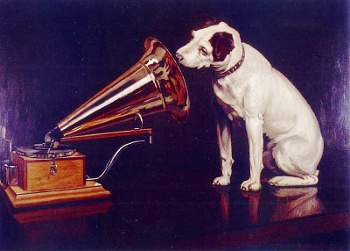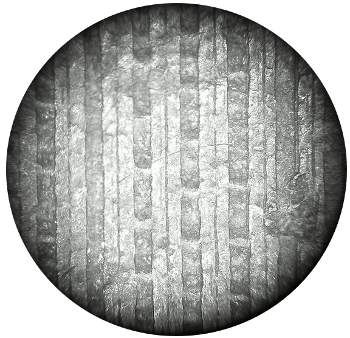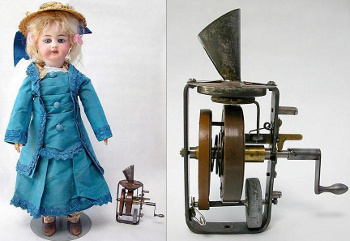His Master's Voice
August 15, 2011
In the days before ubiquitous
electronics,
inventors needed to use
mechanics and simple
electrical circuitry to create useful items.
Thomas Edison was a master of these simple crafts, and I wrote about his
patents in such diverse fields as
magnetic ore separation (Edison's Iron Mine, September 20, 2010) and the
casting of concrete houses (People Who Live in Concrete Houses, June 30, 2011).
It's well known that Edison made pioneering advances in the
media players of his age,
movie projectors[1-2] and
phonographs. He didn't do anything with a competing media technology, the
player piano. His list of patents is huge,[3] although he sometimes required that he be named as the inventor of technologies he acquired, and did not invent, such as the
Vitascope.[4]

His Master's Voice.
Portrait of the dog, "Nipper," at the horn of a phonograph by Francis Barraud (1856-1924).
This image was used as the trademark for the Victor Talking Machine Company (1900) and RCA (1929).
(Via Wikimedia Commons))
Anyone who's scratched fingernails on a
blackboard knows that sound production is possible by moving a
stylus across a surface. It's also obvious by moving a stick along a
picket fence, and putting a
baseball card in contact with the
spokes of a
bicycle wheel, that a wide range of
frequencies can be produced depending on the rate of movement along the corrugated surface.
An inventor of Edison's time would realize that this could be a means of music and speech production. The problem, of course, is how to record the surface undulations that comprise music or speech. Edison solved the problem by using a soft material,
tin foil, that would record the sound as undulations in the material, somewhat like making a special picket fence.
These undulations were in-and-out of the plane of the tin foil (vertical), and not the transverse squiggles found in later recordings. The first such tin recordings were made in 1877 for primitive
dictation machines. These tin recording could only be played a few times, but this was enough for
typists to render the dictation into typescript.[5]

Grooves in tin foil audio recording.
(Image via National Park Service)
An example tin foil recording was discovered in 1967 on the grounds of Edison's New Jersey factory, which is now the
Thomas Edison National Historic Park,
West Orange, New Jersey. The tin recording, in the form of a tin
cylinder, was so
out of round that it was not playable by its usual means, so Earl Cornell and Carl Haber at the
Lawrence Berkeley National Laboratory were asked to develop a method of playing the recording non-destructively using
optical techniques.[5]
The tin cylinder had the following dimensions:[6]
• Outer diameter (shape corrected): ~2-3/8 inch (~60.4 mm)
• Inner diameter (shape corrected): ~2-1/8 inch (~53.7 mm)
• Width: ~7/16 inch (~11.4 mm)
• Thickness: ~1/8 inch (~3.4 mm)
• Grooves per inch: 50
Using
confocal microscopy, they were able to image the recorded groove on the tin cylinder to a tenth
micrometer depth resolution. These data enabled generation of a
topographic map that allowed generation of an audio file. The recording was a twelve second rendition of "
Twinkle, Twinkle, Little Star," spoken by a young woman (MP3 file
here).[7]
Unfortunately, the first
syllable of the first word could not be recovered. The recording was for a
talking doll, dating from 1888 via newspaper ads by historian,
Patrick Feaster, of
Indiana University (Bloomington, Indiana) and
Phonozoic.[6]

You ought to be in pictures; talking pictures, that is.
Edison talking doll and its phonograph mechanism.
(Image courtesy of René Rondeau, used with permission)
The
US National Park Service hosts an archive of about 28,000 disc phonograph records, 11,000 cylinder phonograph records, and 9,800 disc metal molds at the Thomas Edison National Historical Park. Some of these can be accessed online at
their web site.[8]
Techniques have been developed for non-destructive play of mechanical recordings, usually by
laser techniques. Such a task is not easy. The first laser phonograph patent runs fourteen pages.[9]
References:
- Thomas A. Edison, "Stop Device," US Patent No. 491,993 (February 21, 1893).
- The Inventions of Thomas Edison, History of Phonograph - Lightbulb - Motion Pictures, Inventors.About.com.
- Edison Patent List, Inventors.About.com.
- History of Edison Motion Pictures: The Shift to Projectors and the Vitascope (1895-1896), memory.loc.gov.
- Ron Cowen, "Scientists Play World's Oldest Commercial Record," Science Now, July 6, 2011.
- Early Talking Doll Recording Discovered, US National Park Service.
- Talking Doll Record, Edison talking doll tin cylinder, Edison Laboratory, West Orange, New Jersey, circa November 1888, NPS object catalog number: EDIS 1279.
- Listen to Edison Sound Recordings, US National Park Service.
- William K. Heine, "Disc phonograph record playback by laser generated diffraction pattern," US Patent No. 3,992,593, November 16, 1976.
Permanent Link to this article
Linked Keywords: Electronics; invention; inventors; mechanics; electrical; Thomas Edison; patent; magnetic ore separation; casting of concrete houses; recording medium; movie projector; phonograph; player piano; Vitascope; His Master's Voice; Wikimedia Commons; blackboard; stylus; picket fence; baseball card; spoke; bicycle wheel; frequency; tin; dictation machine; typewriter; typist; Thomas Edison National Historic Park; West Orange, New Jersey; cylinder; roundness; Lawrence Berkeley National Laboratory; optical; confocal microscopy; micrometer; topographic map; Twinkle, Twinkle, Little Star; syllable; talking doll; Patrick Feaster; Indiana University (Bloomington, Indiana); Phonozoic; René Rondeau; US National Park Service; laser turntable; US Patent No. 491,993; US Patent No. 3,992,593.